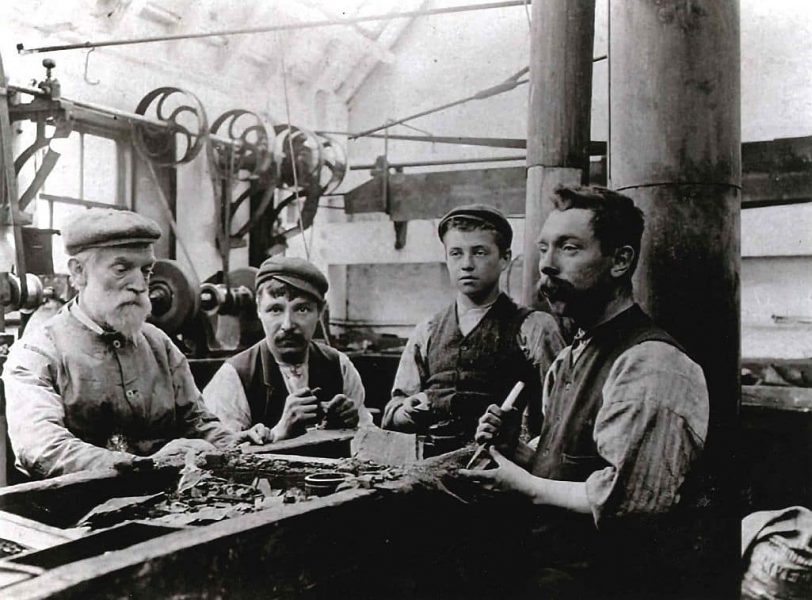
Beautiful Jet has been produced in Whitby for generations
During the 1860’s and 1870’s there was full employment in Whitby. A bustling coastal town; if a person was not already employed in the fishing industry, they could just as easily turn their hand to some facet of the jet trade. This included the mining and procuring of jet, the rough jet dealers who acted as an intermediary between the miners and the craftsmen, the lapidary and manufacturing sector and the wholesale and retail merchants.
Whitby’s jet workers included people from all walks of life.
Official documentation from the period suggests that the people who worked in the industry were of the ‘lowest and least educated class in the town’, and while it is true that many jet workers were illiterate and poorly educated, they were also proud family men who lived principled lives; working hard to provide for their dependants, always attending church on Sunday’s and becoming some of the most artistically brilliant designer/makers of a generation
Irregular working hours were a characteristic of the jet workers’ occupation. In theory, they worked Monday to Thursday, with each day beginning at 6am, with an hour off for lunch and ending when the market square clock tolled 6pm. The reality, however, was many men choosing to work as late as eight and nine in the evenings, especially during the Summer months when long, light nights allowed it, thus allowing them to take an even longer weekend or enjoy the extra wages accrued. This kind of routine, however, was considered less respectable than working the customary days and hours expected.
As long as their Sundays were spent at Church and at prayerful rest, their free days were theirs to spend how they wanted, usually down at their local, The Jet Men’s Arms, once located at number 79 Church Street.
It was also not unusual for children to work in the Whitby jet industry. The average starting age was around eleven or twelve years old, but the youngest documented was only seven. Not surprisingly, most of these children had not attended much school, if at all, and they usually came from the poorest households, many of them being the sons of seamen’s widows who felt compelled to begin work at a young age in order to help support their families.
The early years of the Jet Industry
In the earlier years of the jet trade, there was little in the way of an official training given to these new starters, it was not until the industry became more established that proper apprenticeships were put in place. A contract of five years was the usual term for an apprentice, although terms of three, four and as many as seven years have been recorded.
To begin with, the young lads were sweeping floors, running errands and washing finished pieces, the first specialist process they learnt was polishing, where they used pieces of string to reach the insides of fine cuttings and carvings, their small, nimble fingers ideal for the delicate task. After their long day at work, they would then receive one hour of expert tuition from their employers in the evening and were further encouraged to take evening classes in design and drawing to help with their overall skill and proficiency as a future master jet carver.
Whitby Jet Showcased
After the Great Exhibition of 1851, when Whitby jet ornaments were showcased to worldwide acclaim, it became good practice for the best jet workers to enter their finest work into national and even international competitions.
One notable entry was to the Turners’ Company at Mansion House, London, where it was remarked by a lecturer of sculpture that the submissions possessed ‘great originality and elegance of taste’ and was astonished at the level of commendation bestowed upon it, ‘considering whence it came’. In the end, the silver medal of the Turners’ Company was awarded to a Whitby craftsman who exhibited a carved jet ink stand. It was noted afterwards that the Whitby men had become so proud and joyous that they had become ‘rather disorderly.’
Local Jet Craftsmanship
Locally, small competitions were set up in the town to involve and encourage craftsmen of all age ranges and experience, and although many of these creations took far too long to make to ever be financially viable, they were still supported and subsidised by the employer both to promote skill and progress in their workers and also in the hopes of promoting their businesses.
Whitby Jet Industry – Rise and Fall
It is well known that as quickly as the Whitby jet industry ascended to its dizzying heights of success, swift too was its fall from triumph, precipitated by dramatic changes in fashion, the introduction of cheaper, imitation materials and most ruinous of all, jet’s morbid association with death and mourning that did not fit with the bright and cheerful new designs of the approaching new century. The result was the swift decline of one of Whitby’s most historic industries, and in the space of just ten years from 1874 – 1884 the number of jet workers had dropped by over a thousand.
It would take the best part of a century for the jet trade to once again attain the popularity and appreciation that it once had, from a new generation of customer who rate its qualities not on fashion, but on its rarity, history and beauty.
Written by: Rebecca Tucker
Curator at The Museum of Whitby Jet
If you are travelling to the Yorkshire coast, Whitby is a definitely worth a visit.
The Museum of Whitby Jet is a visual feast for the eyes and a fascinating insight into the history and heritage of one of Britain’s most iconic gem materials. With a focus on telling the story of Whitby jet, from its geological formation to its popular uses throughout history and becoming one of the most successful gemstone materials ever used in jewellery manufacture, the museum takes you on a journey through time with some of the most fantastic examples of Whitby jet jewellery and ornaments you will ever see.
Buy Beautiful Whitby Jet Jewelery
W Hamonds Jewellers is established as the original Whitby Jet store, recognised as leading British gemstone specialists since 1860. With stores located in York, Leeds and Whitby, situated at the top of Whitby’s historic Church Street, W Hamonds proudly continues the British gemstone’s legacy





